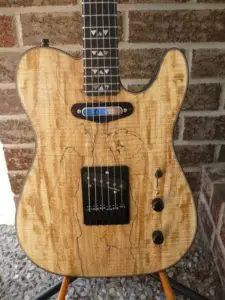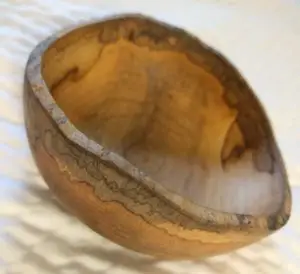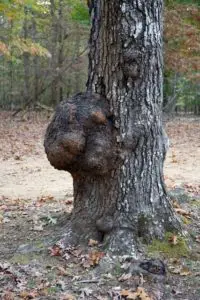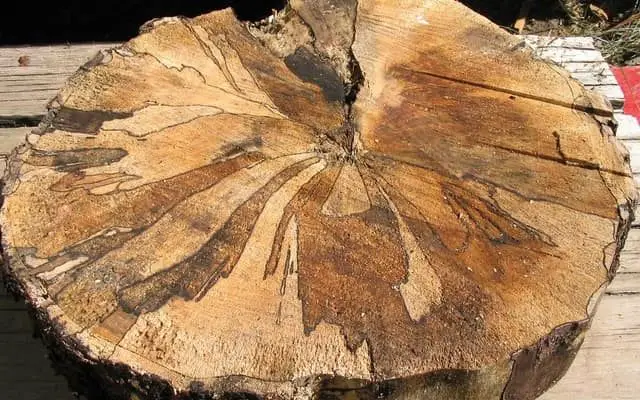Most people don’t realize what spalted wood is when they are looking at it. Often, though, if you have multiple pieces of wood laying out on a table, people are going to be attracted to the piece that is spalted due to it’s unique and beautiful color and design in the wood.
In the article below, we’ll cover what spalted wood is, what it can be used for, and look at some of the myths that exist with it.
What Is Spalted Wood?
Spalted wood is any wood that has begun to decay or rot as a result of a specific range of airborne fungus. It is created when white rot fungus begins growing within a piece of wood or log.
When the fungus begins to grow withing the wood, the process is referred to as “spalting.”
Spalting is most likely to occur in hardwoods, but can, if conditions are right, occur in softwoods as well.
In order for spalting to occur within wood, there are three conditions that must be present in order for the fungi to grow properly. Those factors are: temperature, oxygen and moisture.
Temperature – Studies have found that white rot fungi grows and spreads best when wood temperatures are between 70 and 100 degrees Fahrenheit.
Moisture – The moisture content of the wood needs to be above 25%. However, wood can not be submerged in water due the fact that it prevents oxygen from getting to the fungi. Keeping wood in a dark and damp location helps keep it from getting to dry for the fungi to grow.
Oxygen – The fungi needs to be able to breath in order to grow. There is no set amount of oxygen needed in order for the fungi to grow successfully.
Since spalted wood is a piece of wood that has begun to rot, it’s important that you stop the spread of the fungus before the piece begins to lose its strength. In order to stop spalting from continuing, you simply place the piece of wood in a dry location and prevent moisture from getting to it.
Myth
One of the most common myths that you may hear regarding spalted wood is that it is created from bugs, insects or bacteria that is living in a piece of wood. These are simply not true. These organisms can (and do) live in wood. They can also create designs in wood by boring holes into wood. However, designs or imperfections in wood caused by these pests are NOT spalted wood.
What can you do with spalted wood?
Spalted wood can be used for anything that regular wood can be used for. Due to the  unique design in spalted wood it should be used in pieces that are going to be visible. You will not want to use it on the backside of a dresser where the wood will not be visible.
unique design in spalted wood it should be used in pieces that are going to be visible. You will not want to use it on the backside of a dresser where the wood will not be visible.
Spalted wood is very popular among wood turners or those who cut pieces using a wood lathe. The random lines and and patterns in the wood can make some amazing designs in wood that is turned or made into rounded shapes. Some examples of this are handles for utensils, urns, pens and bowls.
Spalted wood is not limited to only those who turn it on a lathe though. It can also be used on larger pieces such as table tops and even guitars. Prices for boards that are large enough for tables can get expensive due to the size and the scarcity factor of spalted wood in general.
Is spalted wood dangerous?
One of the biggest myths or misconceptions in the world of woodworking is the perceived or assumed danger associated with spalted wood. It’s likely this myth began because someone assumed that since spalted wood is associated with mold spores that it must be extremely dangerous to work with.
Studies have shown that spalted wood is actually no more dangerous to woodworkers or those who have the wood in their homes than any other wood pieces.
With that said, you do need to take every bit of precaution when working with wood (whether it’s spalted or not) to prevent the dust and spores from getting into your lungs. There have been cases of people having allergic reactions to the inactive fungus spores contained within spalted wood.
You’ll find plenty of options available when it comes to masks to prevent you from breathing saw dust. I just picked up this mask off Amazon and I really like it. Does a great job of sealing off my mouth and nose and prevents me from inhaling and dust.
Can spalted wood be used around food?
This is a controversial topic. Woodworkers will make the argument for both sides. Thus far, there’s no true scientific findings on what the correct answer.
The conservative viewpoint on this question is that it’s simply not work the risk of  using wood on pieces that are going to be around food. Since spalted wood is made from fungus spores, people on this side of the argument conclude that there is a risk of bringing food into contact with wood that has one point had fungus growing in it.
using wood on pieces that are going to be around food. Since spalted wood is made from fungus spores, people on this side of the argument conclude that there is a risk of bringing food into contact with wood that has one point had fungus growing in it.
The folks on the other side of the argument claim that, we long as you aren’t using any types of wood with large pores (walnut, red oak) that it’s perfectly fine to use spalted wood around food if you apply a food safe finish, such as this. The thought is that the finish will seal any spores (dead or alive) into the wood and thus kill them.
Ultimately, this is a decision that will be left up to you as the woodworker. There are many beautiful things that can be made with spalted wood, even if you decide to stay away from pieces to be used in the kitchen.
Tree Burls
Tree burls are another type of deformity that can appear on a tree that will significantly impact the grain, rings and color on a piece of wood. Burls are different from spalted wood in that their abnormality is often caused by damage that has occurred to a tree. Burls are often described as a wart that has formed on a tree.
A burl will often appear on a tree due to some sort of stress that Mother Nature has inflicted, which can include an insect or disease attack. As the burl grows, it will look  almost like a bubble growing from the damage section of the tree. This distortion is what causes the wood grain and color to acquire it’s uniqueness.
almost like a bubble growing from the damage section of the tree. This distortion is what causes the wood grain and color to acquire it’s uniqueness.
Burls can come in a wide range of sizes. The difficultly to working with burls for woodworkers is the fact that burls are prone to cracking or breaking due to the irregularities that have formed within them. Since their growth is due to stress or damage to the tree, the inside of a burl could contain piece of bark that have been overgrown which could leave pockets or voids within.
The most highly desirable pieces of burl are those that have formed “eyes” within the wood grain. These are the most difficult pieces to fine, and unfortunately you can not tell if a burl has created this look until the burl has been removed from the tree.
How much does a burl cost?
There are a lot of factors that go into the figuring out a price for a tree burl. The size and species of wood are the two biggest drivers for price. It’s not uncommon to pick up some small pieces for as little as $20 or so. This should be plenty for turning small pieces such as pens or something. Larger burls can go for several hundred dollars. If you can find a large burl on a species of wood that doesn’t normally grow burls, you can expect to pay north of $1,000.
Related Questions
Can you burn spalted wood? Yes, it’s completely fine to burn spalted wood. However, I’d encourage you to use the wood for something else rather than in a campfire. If you aren’t a woodworker, it’s very likely that you can list is for sale somewhere locally like Facebook Marketplace and make a few bucks depending on the species of wood and the amount you have available. Spalted wood is always in high demand due to its difficulty to find.
What is the difference between spalted maple and ambrosia maple? These two types of maple can be similar but are made in very different manners. As we’ve covered in the article above, spalted wood is created from fungus growing inside the tree. Ambrosia is created by beetles that burrow their way into the trunk of a tree and discolor the wood as they tunnel through it.




